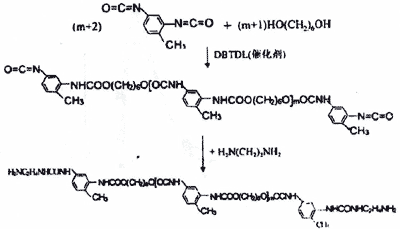Study on Application of Epoxy Flexible Adhesive Curing Agent
Abstract : An amino-terminated polyurethane (ATPU) was synthesized by the reaction of toluene 2,4-diisocyanate with hexanediol and ethylenediamine, and an adhesive was prepared with bisphenol A epoxy resin. The relationship between the reactant ratio and the molecular weight of ATPU and the effect of ATPU molecular weight on the overall mechanical properties of the adhesive were investigated. It was found that as the molecular weight of ATPU increases, the flexibility of the adhesive increases, the adhesion decreases, and the peel strength appears at a maximum. The results show that through the molecular design and synthesis of a certain structure of flexible conditioners can improve the overall mechanical properties of epoxy adhesives, it is expected to achieve its application in the aircraft wave absorbing coating.
Keywords: epoxy resin adhesive; flexible curing agent; wave absorbing coating; amino terminated polyurethane
The epoxy resin adhesive has the advantages of low price, stable process, good compatibility with the microwave absorbent, high filling amount, room temperature curing, strong adhesion, corrosion resistance, etc., making it superior to chlorosulfonated polyethylene and polyurethane, etc. Adhesives become the preferred adhesive material for microwave absorbing coatings<1>. In order to improve the poor flexibility of conventional epoxy resin curing systems, a large number of toughening modifications were studied using a certain molecular weight of synthetic rubber <2-4> or reactive toughening agent <5>. By controlling the size and distribution of the rubber dispersed phase, the flexibility of the adhesive can be significantly improved while still maintaining a good adhesive strength to metals, but at present this technology has not yet made it possible for the epoxy resin adhesive to satisfy the ultrasonic wave absorption of the aircraft. The high requirements of the coating <1>.
Considering that polyurethane contains a large amount of urethane groups, ether bonds, and the like, it has excellent adhesion, abrasion resistance, corrosion resistance, flexibility, and the like, and the room-temperature curing flexibility of the epoxy resin through molecular design and development. There are few reports of curing agents. This article synthesized amine-terminated polyurethane (ATPU) as a flexible curing agent for epoxy resins, and used it and epoxy resin as adhesives to test the mechanical properties of adhesives such as adhesion, peel strength, and flexibility. ATPU molecule one relationship.
1. Experimental part
1.1. The main chemical reagents
Toluene 2,4-diisocyanate (TDI), LR, vacuum distillation under N2 protection, collecting fractions at 104°C/133 Pa; E-44 epoxy resin, industrial grade, produced by Yueyang Petrochemical General Factory; other reagents Chemically pure or analytically pure, used after drying one day with 4A molecular sieves.
1.2. Synthesis of amino-terminated polyurethane (ATPU) and determination of its molecular weight

Figure 1 ATPU synthesis route, where the integer m ≥ 0
The synthesis route is shown in Figure 1. The measured hexanediol-dimethyl sulfoxide solution and dibutyltin dilaurate (DBTDL, 0.3-0.5% of the total amount of hexanediol and TDI) were stirred under room temperature of 20°C and N 2 atmosphere. A solution of 4-methyl-2-pentanone containing 0.05 mol of toluene 2,4-diisocyanate (TDI) was added dropwise. The reaction was then stirred at 60[deg.]C under constant temperature for 12 hours. Then, the mixture was cooled to room temperature, and slowly dropped into a solution of 0.025 mol of ethylenediamine in dimethyl sulfoxide cooled with an ice-water bath under N2 atmosphere and stirred, and then the reaction was stirred at 40°C for 2.5 hours. Excess ethylenediamine and all solvents were removed in vacuo to give ATPU. The amount ratio of the substance controlling TDI to hexanediol is greater than 1 and the amount of hexanediol material can be varied to obtain ATPU products of different molecular weights.
1.3. Determination of the molecular weight and water absorption of ATPU
Determine the molecular weight using the method of end group analysis<6>: Accurately weigh WSP (about 1.0 g) of ATPU and completely dissolve it in 20.0 ml of N,N-dimethylformamide (DMF) to bromocresol Green indicator, titrated with approximately 0.05 N HCl-DMF solution. The number average molecular weight is calculated using formula (1): Mc=2Ws/(Vs-Ve)N(1); where Ws is the weight of the sample ATPU; Vs is the volume of HCl solution required to titrate the sample ATPU; Ve is the titration 20.0 ml The volume of HCl-DMF solution required for DMF; N is the equivalent concentration of HCl-DMF solution.
W1g ATPU was made into a sheet of 10 mm × 20 mm, immersed in distilled water for 48 hours and then taken out. The surface moisture was sucked with filter paper, and then W2g was weighed. Calculate the water absorption rate of ATPU Rw=(W2-W1)/W1×100%.
1.4. Adhesive preparation and testing of mechanical properties
The bisphenol A epoxy resin (E-44) is mixed with the appropriate amount of ATPU and the diluent (content in the adhesive is 28%), and the adhesive is prepared. Aluminum alloy test panels to be painted according to aerospace aluminum surface phosphating process are surface treated <2>. The test piece was painted at room temperature with a coating thickness of approximately 0.6 mm. The mechanical properties were tested after curing at 80°C for 6hrs. The adhesion, flexibility, and peel strength of the adhesive coating were measured according to the National Standard for Love GB 5210, GB 1731, and GB 2790, respectively.
(to be continued)
Printed Birthday Design Bag, Birthday Design Bag, Birthday Gift Bag
Paper Shopping Bag Bottle Series Co., Ltd. , http://www.yide168.com